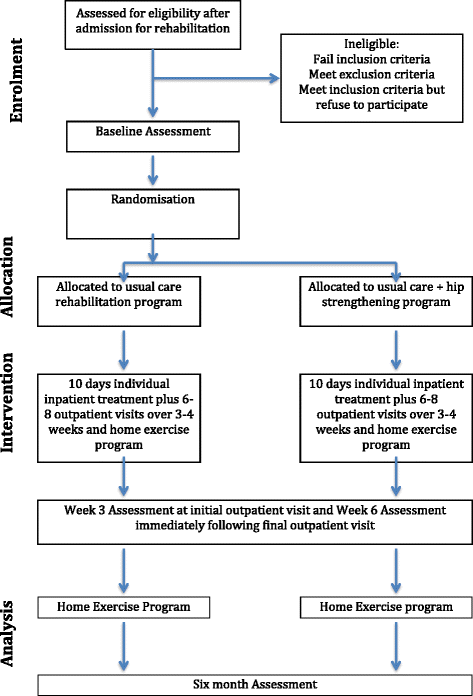Does the addition of hip strengthening exercises improve outcomes following total knee arthroplasty? A study protocol for a randomized trial
- PMID: 27295978
- PMCID: PMC4906815
- DOI: 10.1186/s12891-016-1104-x
Does the addition of hip strengthening exercises improve outcomes following total knee arthroplasty? A study protocol for a randomized trial
Abstract
Background: Total knee arthroplasty (TKA) is effective in reducing pain and improving function for end-stage knee osteoarthritis. However, muscle weakness and functional limitations persist despite assistance from post-operative rehabilitation programs that traditionally focus on quadriceps strengthening and range of movement exercises. Hip abductor muscle weakness is evident in knee osteoarthritis and hip muscle strengthening reduces knee pain in this group. Following TKA, people with weak hip abductor strength perform more poorly on measures of physical function. However, very little is known of the effectiveness of including hip abductor strengthening exercises in post-operative rehabilitation. The aim of this trial is to compare the effects of targeted hip abductor strengthening to those of traditional care in a TKA rehabilitation program on muscle strength, patient reported outcomes and functional performance measures.
Methods/design: This protocol describes a single-blinded randomized controlled trial, where 104 participants referred for inpatient rehabilitation following TKA will be recruited. Participants will be randomized using computer-generated numbers to one of two groups: usual care or usual care with additional hip strengthening exercises. Participants will attend physiotherapy daily during their inpatient length of stay, and will then attend between six and eight physiotherapy sessions as an outpatient. Primary outcomes are isometric hip abductor strength and the Knee Injury and Osteoarthritis Outcome Score (KOOS). Secondary outcomes are stair climb test, 6 min walk test, timed up and go, 40 m fast-paced walk test, 30 second chair stand test, isometric quadriceps strength, Lower Extremity Functional Scale (LEFS) and SF-12. Outcome measures will be recorded at baseline (admission to inpatient rehabilitation), and then 3 weeks, 6 weeks and 6 months post admission to rehabilitation.
Discussion: The findings of this study will determine whether the addition of targeted hip strengthening to usual care rehabilitation improves physical performance and patient reported outcomes following TKA when compared to usual care rehabilitation. This will then determine whether targeted hip strengthening exercises should be included in traditional rehabilitation programs to improve the outcomes following total knee arthroplasty.
Trial registration: The trial protocol was registered with the Australian Clinical Trial Registry ( ACTRN12615000863538 ) on 18 August 2015.
Keywords: Exercise; Hip strengthening; Randomized controlled trial; Rehabilitation; Total knee arthroplasty.
References
-
- Petterson SC, Mizner RL, Stevens JE, Raisis L, Bodenstab A, Newcomb W, et al. Improved function from progressive strengthening interventions after total knee arthroplasty: a randomized clinical trial with an imbedded prospective cohort. Arthritis Rheum. 2009;61(2):174–183. doi: 10.1002/art.24167. - DOI - PubMed
Publication types
MeSH terms
Associated data
LinkOut - more resources
Full Text Sources
Other Literature Sources
Medical


